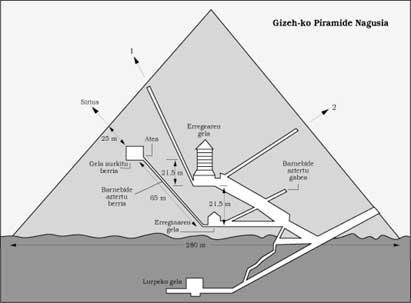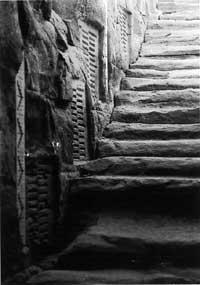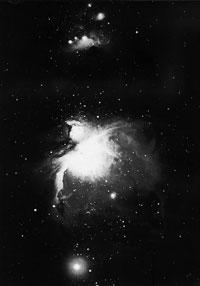New inner path in the general pyramid of Gizeh
1993/06/01 Arregi Bengoa, Jesus Iturria: Elhuyar aldizkaria

In the last issues we have used a current issue, with some curiosities of black holes. On this occasion, however, we will change radically and take care of the time when astronomy began to develop. The excuse for this is news that comes from Egypt last month and that, although its astronomical content is small, shows the concern of the oldest peoples for astronomy.
The news indicates that a team of German scientists has found a new room in the Gizeh Main Pyramid, at the head of an internal track 65 m long. The slope of this inner vial is slightly higher than eighty degrees and R. According to the Belgian Egyptian Bauoval, when the pyramid was built he headed towards the Sirius star of the Constellation of Major Canis. This star is the brightest on Earth. The Egyptians called Shotis and regarded Isis as the image of the goddess.
To study ancient science, two (and almost exclusively) main aspects must be taken into account: Astronomy and Mathematics. However, in these cases development is not due to curiosity or interest in discovering the reason for different phenomena, but rather to everyday needs. Mathematics, for example, was necessary for trade (arithmetic) and land construction and measurement (geometry). It should be noted that, after the annual floods of the Nile River, land redistribution caused the Egyptians great problems of surveying.
The development of astronomy is not surprising. The periodic movements of the stars allowed to measure time and carry out the first calendars. For example, the Nile floods we have mentioned were done very accurately and, of course, the development of a flood forecast schedule was an urgent problem. As mentioned above, the whole of knowledge acquired at that time was not acquired with the thirst to explain phenomena or to relate, but the first step in the development of science, data collection, was done quite accurately. The result of this responsible work was to link the heliac exit of the Syrian star with the beginning of the floods of the Nile River.
The helian exit of a star is the first one that occurs at dawn. As the sun immediately comes from behind, its luminosity covers that of the star, which is only seen in a very short time. By chance, then, Sirius's heliac exit occurred when the Nile floods were about to begin, so Sirius was considered its advertiser.
If for primitive man the stars were the object of spontaneous worship, coincidences similar to those described served to deepen this mentality, ultimately establishing the belief of the existence of a causal relationship between the phenomena of Ortz and Earth. This led to the development of astrology and, of course, the power of the priest who was concerned with the study of kneading, data collection and subsequent interpretation.
The logical consequence of this is also the religious use of astronomy. This is the case of the pyramids. Great Pyramid of Gizeh, tomb of Pharaoh Keops, a. C. It was built around 2500 following certain astronomical directions. Square plan 230 m long, with very precise faces in north-south and east-west directions.
Within this structure of six million tons some interior roads and rooms were also known, but unlike other pyramids, so far nothing has been found: neither the mummy nor the builder's treasure. As can be seen in the figure, the previously known interiors (1 and 2) have been built pointing towards the Constellation belt of Orio and towards the alpha star draconis respectively. Orion’s belt stars are the expression of the god Osiris and the goddess “alfa draconis” Rer. This last star, for its part, was in the areas where the polar star is currently in the study period.
The mentioned room is at the end of an interior road of 65 m. Previously it was considered that the inner path was 8 m long and blind. Its width and height is 20 cm. For this reason, the studio was carried out using a small robot equipped with a video, R. Directed by robotist Gantebrink.
As so often happens, this working group worked with another goal, “Elhuyar. Science and Technology” in the March issue M. R. Laguens and E. Precisely with the aim of solving one of the problems mentioned by Ezpeleta in his article entitled “The enigma of esfing” (pollution introduced by tourism, or more specifically by the 20 grams of water that each tourist leaves in the surroundings of the pyramid through breathing and sweat). Therefore, the special work of the robot was to analyze the drafts within the pyramid. He has also found clues from these currents.
The ranges of about 2 mm that leaves to the sides the portillo located at the end of the interior are closed with black powder. This powder cannot be made of stone, as it is fermented or yellow limestone. Therefore, it is what comes from inside the room. The means of transport are, of course, air currents. On the other hand, the presence of these currents suggests that the room should be large enough. A final clarification of the powder color can also be obtained. Black dust can be the organic matter that generates the decomposition of wood and tissue, as we know from other pyramids. If so, this room could also house Pharaoh's treasure or the mummy itself.
As can be seen in the figure, no other inland road to the north is yet analyzed.
SUN: June 21 at 8 h 59 min (UT) enters Cancer. So summer begins.
Total Lunar Eclipse: 4 June, not visible in Euskal Herria. It can be seen in America, Alaska, Australia and Asia. PLANETS MERCURY: we can see it in the middle of the month at dusk. The 17th of June passes through its maximum elongation, 25th. |

Gai honi buruzko eduki gehiago
Elhuyarrek garatutako teknologia






